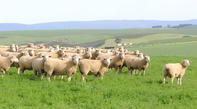The feeding of sheep is an important component of sheep farming, as sheep obtain their nutritional requirements from the pastures they graze on or through feed when they are based in intensive farming systems. A balanced diet should include protein, energy (such as fats and carbohydrates), vitamins, minerals and fresh water.

The exact requirements of feeding of sheep is a complex topic. Not only is feeding determined by the type of sheep farming system (extensive or intensive) and the sheep breed but the quality of feed.
The production cycle of a sheep such as weaned lambs or lactating ewes and gender also determine the feeding regime of a sheep. For example, young rams can grow up to 26% faster than their sisters.
The best advice on feeding sheep is to consult a nutritional advisor in your specific region.
Types of Sheep Feed
Sheep feed can be divided into three categories - roughage, feed concentrates and supplements.
Roughage includes dry and green roughage, silages and pastures.
Feed concentrates include carbohydrate-rich low-protein concentrates and protein supplements.
Supplements will include minerals, vitamins and non-protein nitrogen such as urea.
Quality of Feed
When grain is used for sheep feed, ensure that is protected from insect infestation and dry to at least 12% moisture. A higher moisture level can lead to mould which can be toxic to animals.
If pastures are used for hay, ensure the correct moisture level of between 15 - 18% before baling. Too dry and nutrients will be lost, too wet and hay bales will rot.
The size of hay particles can determine the usage of the feed. The best use is when hay is ground or pelletised. Ground hay can be mixed with maize meal or molasses.
Feed Concentrates
Grains and seeds are low in fiber and thus highly digestible. Due to its high cost, feed concentrates are used to supplement grazing at specific times during a sheep’s production cycle, for example during late pregnancy and lactation.
Supplements
Few raw materials will provide all the nutrients needed by sheep. The addition of macro minerals (e.g. Ca, P, Na and Mg), trace minerals (Cu, Co, Mn, Fe, Iron, Se and Zn) as well as vitamins such as A, D and E, will provide in the needs of high-production animals such as growing lambs and lactating ewes.
What is Supplementary Feeding?
In sheep farming, supplementary feeding comes in the form of grain and/or protein concentrates and provides energy or protein when the pasture, veld or stubble is lacking. Roughages such as hay and silage will be provided as a supplement to veld only when there is a shortage of available plant material.
‘Indigenous sheep breeds are generally well adapted to their environment in extensive veld-grazing farming systems and will under most conditions not require supplementary feeding, says Jan Hoon, an animal nutrition specialist from the Grootfontein Agricultural College. Supplementary feeding is therefore not standard practice with indigenous sheep breeds.
When used, supplements for shrubland grazing will have an energy base, while supplements for sheep grazing on marginal grasslands will have a higher protein content. Minerals, including trace elements, will form part of both grassland and shrubland supplements.
Sheep Farming Systems
Farmers run their sheep enterprises using natural grazing, pastures or intensive feeding systems. Often a combination of all is used. Feeding sheep will vary according to the quality of the grazing that is available.
Feedlot systems are often used to ‘round off’ a sheep before slaughter and requires a well-balanced feed formulation high in good quality protein to ensure fast muscle (meat) development. When cost is not a factor, the concentrate portion of a feedlot ration can make up 70% of the ration.
The feedlot ration may also be adapted depending on the age of the animals.
Feeding of Sheep Breeds
A sheep’s feed can be adapted according to the type of breed to ensure optimum growth for meat production or to improve wool quality.
Certain breeds such as indigenous sheep exhibit a good feed-to-weight conversion even on limited grazing, while other breeds need a finely tuned feed ration to ensure optimal growth.
Some farmers may choose to supplement the diet of the fiber-producing sheep with good quality protein which enhances fibre (wool or hair) growth. Often, these supplementary feeding will include sulphur which is a building block of fibre.
Production Cycle of Sheep
Feeding the right feed at the right time of a sheep’s development is crucial. The reproductive ewe has the most variable feed requirements of any class of sheep and properly providing in her nutritional requirements will have the biggest impact on profitable production.
Please note:
Information is for educational purposes and is not intended to advise or prescribe feeding regimes. Contact an animal nutritionist or animal feed supplier for advice on specific feeding requirements.
By Marinda Louw